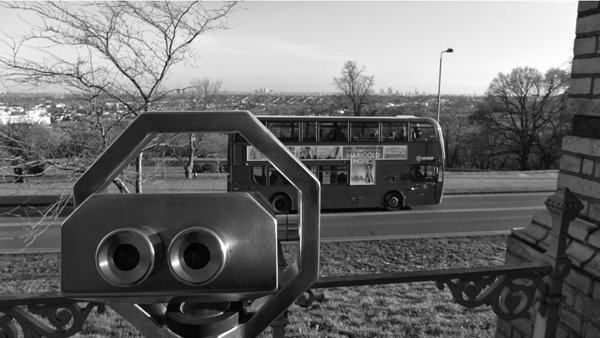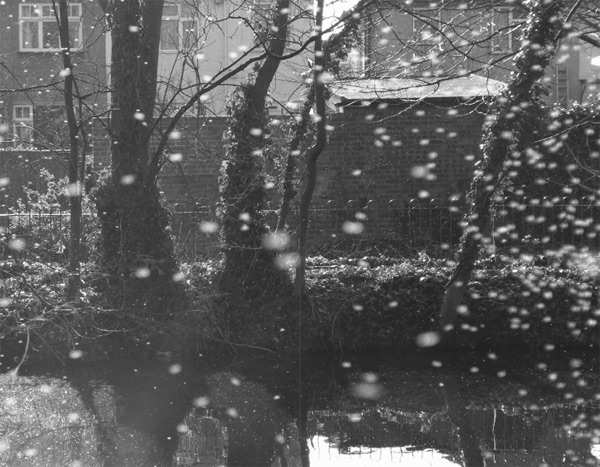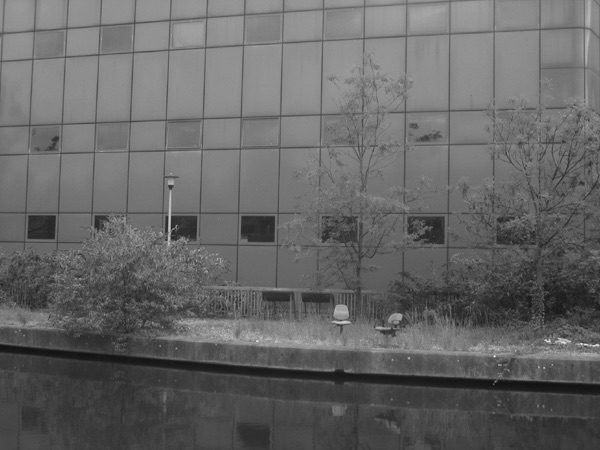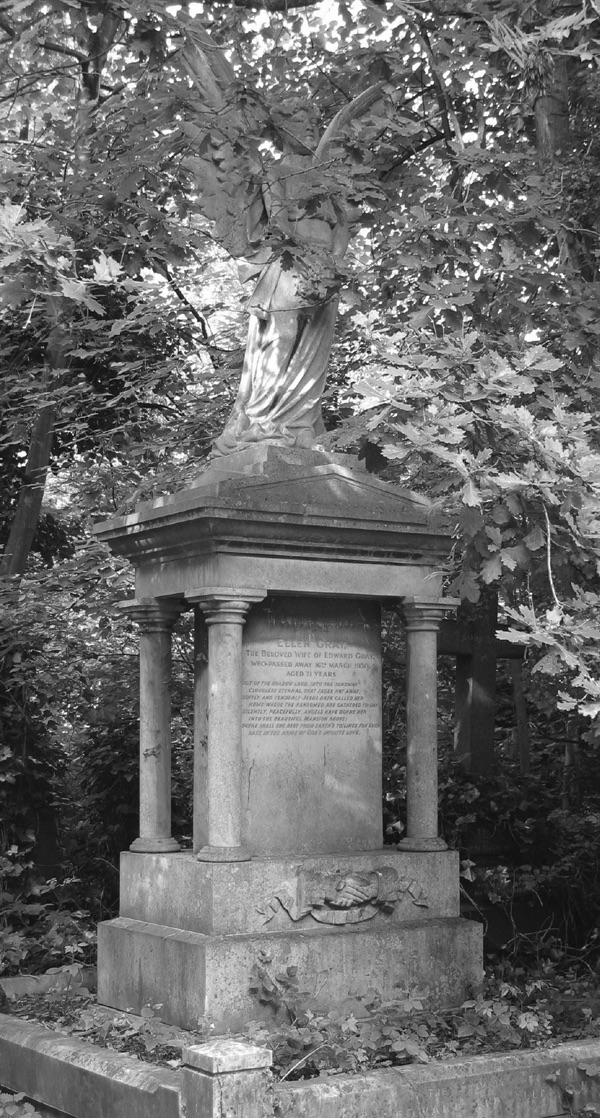Nobody understood why I wanted to spend a month in North London during the winter. My wife had landed a precious academic sabbatical. Emily had zero interest in walking freezing rainy February streets haunted by her childhood memories of Islington in the age of Margaret Thatcher. We had argued—nothing serious, I hoped—about what to do with this lucky chance of time off. She was ready to start a family, but I hadn’t had a salary in three years. I was forty-one and prone to depression in the years after the Crash. Pushing a stroller as my primary occupation wouldn’t help—or maybe it was just what I needed. We agreed to go our separate ways for some thinking time and meet up in a month to talk things over.
Emily’s Facebook feed started bursting with colorfully filtered snapshots of orange trees in Seville, carnival singers marching through sun-splashed Cádiz. I looked outside and saw a spider’s web of electrical wires looming in the cold mist above the gray brick rows of terraced houses near Finsbury Park, N4. Late afternoon gloom gathered in the secluded nooks of the park and the abandoned rail stations whose vanished tracks now formed a footpath to Highgate. I envisioned the diesel fumes of stalled-out rush-hour journeys choking the intersection between the Underground station and the Finsbury Park Mosque. The sodden gutters near Seven Sisters Road and Blackstock Road linked betting shops and Ethiopian restaurants, SIM-card kiosk guys and South Asian clothing merchants, the fragrant bagel bakery and the old pub signage for Courage beers and Meux’s Original London Stout. Here was the housing estate off Fonthill Road that replaced a demolished warren where a century ago the local gangs were said to speak their own coded language. In the plaza in front of the station loomed the bowling alley that used to be the Rink cinema. In its heyday the Rink had a seating capacity of over a thousand and plenty of room for prostitutes to operate in the warm darkness during the Great War.
I would have liked to take Emily to visit the animal charity bookshops that faced one another on Blackstock Road—the cat people with their orderly sections and tidy themed displays, and the dog people with their wonderful cramped jumble (or was it the other way around?). These little rooms opened into alternate universes. Behind every shop front in this postcode lay a portal filled with stars. Or so it seemed when the snow drifted like sparks or fireflies in the street-lamps, reflected in dark windows after hours. A bus would gladly take us to Alexandra Palace, where the hill overlooked the entire city from the Olympic Site to Canary Wharf, the City, and the BT Tower. That was my idea of a nice day out, but I would have to go alone.
Emily had already left for Spain, and in February I couldn’t convince anyone else to join me. My wife’s sister, Joanna, lived in Wandsworth, newly married and planning to relocate to Los Angeles. My best friend in Britain, Ben, lived near Waterloo Station. It was possible to entice South Londoners to cross the river but in the winter there had to be some compelling special event, like a holiday dessert you could soak in alcohol and light on fire. Wiser not to move more than a few paces away from the kettle, December to March.
It had been nearly twenty years since I had experienced winter in England. I grew up in snowy Wisconsin, the land of the ice fishermen, and the London winter was much more miserable. Nothing ever really dried out. You could ward off the chill temporarily with things that warmed from within—tea, booze, smokes—but the damp got in your bones. I read about the homeless who drank wood alcohol concocted in illegal stills around the “beds in sheds” in the vast outskirts. Cheap heroin had been flooding back into London for years. Soup, hot beans, the wrapped bundle of grease and boiled fish from the chippie. Drinking chocolate, Golden Syrup, Nescafé, Horlicks, Bovril, or in a pinch just a cube of vegetable stock dissolved in boiling water. (I’d seen my wife do this from time to time over the years—Emily emigrated to America at age thirteen, but this act proved she was still British.) The crazy national logic of cellar-cool beer in winter. Pint after pint, measure for measure. Enough drink to make any social outing seem like a conclave of gutter drunks.


After many jetlagged sleepless mornings and a long ride on a night bus with a broken heater, I got the flu and my brain started cooking itself. Semidelirious, it suddenly occurred to me that I had been having an affair with London, right under my wife’s nose, in her parents’ flat, for almost twenty years. During the time I had been visiting London—since 1996 when I was a student on scholarship at Cambridge—I had become addicted to wandering around the vaguely spleen-shaped area between the A1, the North Circular Road, and the A10. Or maybe I was more like a fake spy, an American tourist working for a fictional international intelligence organization. Collecting useless files and furtive accidental snapshots, street by street. My assignations with invisible lovers or nonexistent espionage contacts took place near statues of cats in Archway, along the canals of the New River, around the Nazi bomb sites of Stoke Newington.
What is it with you and London? Emily wanted to know. On Skype she was relaxing outside on a sunny patio in Seville, talking about an endless succession of warm days and the grammatical complexities of the subjunctive. About palaces filled with fruit trees, tiles, flowers, fountains, and peacocks. Her skin had browned beautifully in the sun, and her green eyes looked greener in the sharp southern light.
London was played out, Emily had been arguing for years. The city had transformed itself into a distasteful pseudo–New York, a playground for the world’s wealthy with their resplendent investment properties and river views. Global real estate developers raised Mordor-Lite towers along the riverside beyond Greenwich, while Australian chain malls dominated Stratford and White City. Rents doubled to clear out the poor. Teachers, artists, and writers fled the city in droves.
What is left? Emily often asked me. Americans eating lunch in Starbucks? Besides, she said, on a purely visual level Seville makes London look like a junkie waking up in a trashed squat with puke in his hair.


I could never sufficiently explain my attraction for London, because it was deeply irrational. I knew that the city remained as fascinating and fucked up as ever, especially on the peripheries outside of Zones 1 and 2. All I could tell Emily was that I wanted to be in London when I was not there. I enjoyed the feeling of being a blundering outsider in a foreign city where I could still communicate, vaguely, even if I never would be understood. I got magnetized by place names on the bus destination signs, Wood Green and Angel Road. I had to go see what splendors awaited the visitor of Mansion Park and Seven Sisters. I searched for rose gardens, magpies, soothing water, and above all, the real locations connected to the films and books I loved. But over twenty years of travels in the city, I kept returning, unconsciously, to bomb sites, damaged buildings, and canals. Like a character in a horror story, I only saw these repetitions in retrospect when all the photographs I’d taken melded together into the same nightmare.
I had a thing for London cemeteries. I wanted to pause in my wet shoes in a garden graveyard in Stoke Newington to find the monument inscription about the area’s civilian dead in the Blitz. On a recent visit I saw a sign that begged whoever stole the flowers from the monument to bring them back. The cemetery gate had been plastered with a pleading notice about a missing cat. But the flier had been defaced so that the cat appeared to be talking back to its owner: “Not coming back but need my meds.” I wanted to revisit the spot in Highgate where William Friese-Greene, the pioneer of British “kinematography,” was buried. Greene went bankrupt funding projects with delightfully fanciful names that filled me with hope. The “biophantascope” was a rapid-fire magic lantern, and the “chronophotographic” camera was designed to create the illusion of moving pictures on celluloid. Nearby, the graves of Karl Marx and Herbert Spencer faced off forever, twin specters haunting London and the world. I planned a stroll in Tower Hamlets Cemetery, near the area where W. G. Sebald wrote of walking in Austerlitz. I discovered a working beehive in a hidden pocket of graves in this corner of the city—honey in the tombs, pollen of the dead, sweets for ghosts and wanderers.
“It seems as if all romance were over,” Virginia Woolf wrote of the early 1930s docklands in The London Scene. “Barges heaped with old buckets, razor blades, fishtails, newspapers, and ashes—whatever we leave on our plates and throw into our dustbins—are discharging their cargoes upon the most desolate land in the world.” Woolf described the complicity of the consumer in world trade and its side effects on people and landscapes: “Because one chooses to light a cigarette, all those barrels of Virginian tobacco are swung on shore.”
London contained everything that had ever been imagined, from every era and every corner of the globe. London became the ocean and the whale as well as the lion and the unicorn, a set of woefully mixed metaphors whose confusions and wonders always seemed to suit my mood. I wanted to donate my smog-blackened lungs and diseased eyes to the city as medical specimens. I wanted to arrange new kinds of views. Snapshots created postcards from my itineraries. On the backs of the pictures, I planned to write a series of love letters disguised as traveling notes. Taken together, they would convince Emily that London was the place for us to live.